 Last Sunday, we had a few special guests joining us on our Semakau intertidal walk. Dr Yaacob Ibrahim, Singapore's Minister for the Environment and Water Resources, finally managed to squeeze out some time from his busy schedule to pay us a visit with his family and friends!
Last Sunday, we had a few special guests joining us on our Semakau intertidal walk. Dr Yaacob Ibrahim, Singapore's Minister for the Environment and Water Resources, finally managed to squeeze out some time from his busy schedule to pay us a visit with his family and friends!
The boat operator got us my favourite boat this time round, with nice little cabins and an open deck, which allowed us to have to great view of the surrounding on our way to the landfill island. We started the boat ride all sunny and bright, and just as we were reaching Semakau, it started pouring. Fortunately, the rain stopped when we were about to start the landfill tour.
We started the boat ride all sunny and bright, and just as we were reaching Semakau, it started pouring. Fortunately, the rain stopped when we were about to start the landfill tour.
The southern-most point of Semakau Landfill is also the southern-most point of Singapore's land that the public can access. We wasted no time in taking a been-there-done-that group photo.
As we were in the van going towards the secondary forest, we saw 3 great-billed herons (Ardea sumatrana)! Great-billed herons are the tallest birds in Singapore. Unfortunately, they were too far away for me to grab a good shot.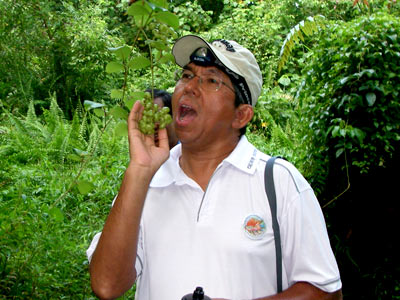
As we were walking through the secondary forest to head to the shore, we saw this pretty vine with cute little fruits dangling off a branch. I think someone told me before that they are related to grapes, but are not edible. Can't remember the name though. Dr Yaacob showed a lighter side of him immediately and struck a comical pose for us :D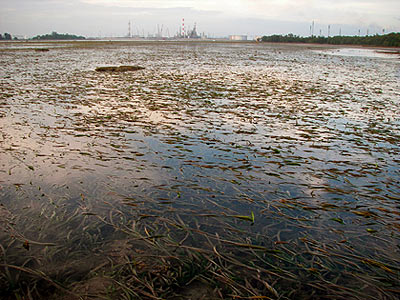
We soon reach the shore, and after crossing the sandy area with lots of fiddler crabs, hermit crabs, creepers snails, sponges, and a pair of coastal horseshoe crabs, we finally reached the beautiful seagrass meadow. Semakau probably has the largest intertidal seagrass meadow in Singapore, and it stretches for kilometres! Seagrasses is the home for many marine animals, especially the juveniles, as there are plenty of food and hiding places. In fact, many of the seafood we eat spend part of their lives in seagrass meadows!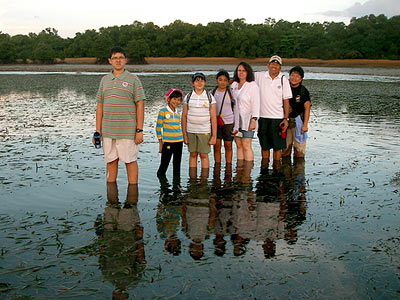
Here's the usual traditional shot of Dr Yaacob, his family and friends crossing the seagrass meadow...
And here's the wacky one! :P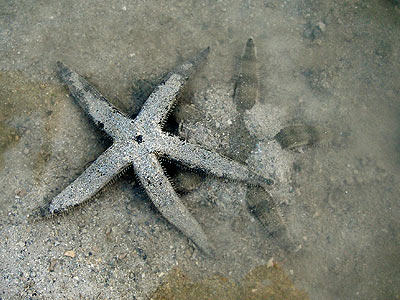
And just after we crossed to the other side, we were greeted by countless common sea stars (Archaster typicus). These sea stars used to be very common on our shores, but we hardly see them on mainland Singapore now, probably due to the destruction of their habitats and over-collection.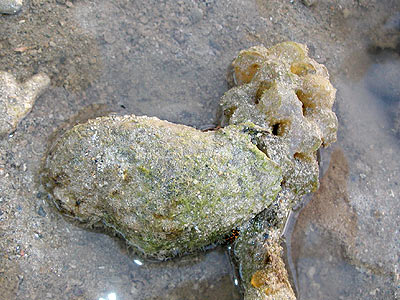
Just the day before, we saw a juvenile noble volute (Cymbiola nobilis), and this time, not only we saw a juvenile again, we also spotted a mother laying eggs! Unlike many other marine snails which hatched in the form of planktons drifting with the currents, baby volutes hatch as little crawling snails. Thus, you don't usually find a particular species in a wide geographical range.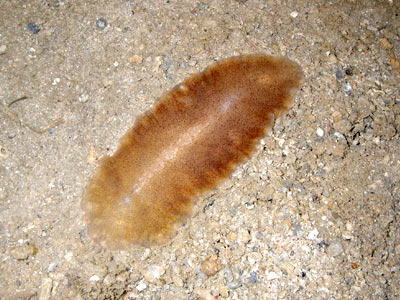
This is the first time I saw this interesting flatworm. It's somewhat translucent and had tiny little brown spots. Near the front end of the flatworm (it's crawling downwards in the photo), you can see a whitish round spot, which is probably the eyespot where numerous eyes form round clusters. The eyes can't really detect images, but are sensitive to changes in light direction and intensity. Other eyespots can be found on its pseudotentacles at its front end too. The other guides later also found us a few of the usual Acanthozoon and Pseudoceros flatworms.
Heard from the hunter-seekers that they found lot of Chromodoris nudibranchs (Chromodoris lineolata). This is actually a sea slug, and the name nudibranch means naked gills, referring to the flower-like gills you can see on its back.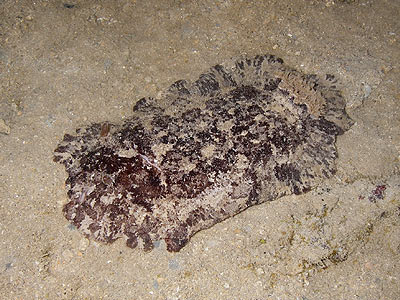
Here's another nudibranch, probably a Discodoris lilacina. Have only seen it once on Semakau before, but guess there could be more of them since they're so hard to spot, being so well-camouflaged among the rocks and coral rubble.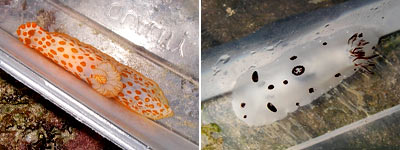
More nudibranchs here, with the orange-spotted nudibranch (Gymnodoris rubropapulosa) on the left, and the polka dot nudibranch (Jorunna funebris) on the right. The former is a fierce slug eater, and eats even fellow slugs of the same species, while the latter feeds on sponges.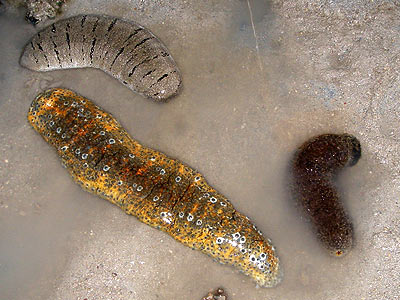
It turned out to be a great day for sea cucumbers, and we've 3 different species here. Anti-clockwise from top left, we have the sandfish sea cucumber (Holothuria scabra), the ocellated sea cucumber (Stichopus ocellatus) and stonefish sea cucumber (Actinopyga lecanora). Getting in-touch with nature is just so much more exciting that just watching it on TV!
Getting in-touch with nature is just so much more exciting that just watching it on TV!
After some quick photos, we quickly put them back into the water, because sea cucumbers use sea water to transfer nutrients in their body, and also to move their little tube feet. Thus, they should never be removed from water for too long, or they will get very stressed.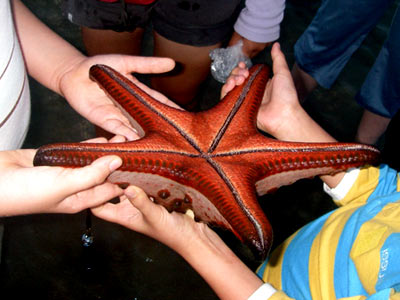
We also found a huge knobbly sea star (Protoreaster nodosus). This brilliantly coloured sea star used to be rather common on our shores too, but unfortunately were getting rarer these days as well due to the loss of their habitat and probably poaching as well. Our visitors managed to take a quick look at its underside and take some quick photos before putting it back into the water. Sea stars are related to the sea cucumbers, and so they get very stressed too if they are removed from water for too long.
We soon had to turned back to shore as the tide was returning, but not before we managed to see a few cute octopuses (which I didn't managed to take any photos) and lots of beautiful corals.
This was certainly a very enjoyable experience for me, and I hope our special guests enjoyed it too.
For me, it's also a rather unique experience, having the opportunity to interact with Dr Yaacob, and seeing the family man in him - the caring husband, loving father and also, as a fun-loving friend - instead of the minister and politician we usually saw on TV or papers.
All in all, another GREAT trip! :)
See also:
1. Semakau Inter-Tidal Walk on 9 March 2008 by JL
2. Semakau Inter-tidal Walk on 9 March 2008 by ST
3. Semakau Walk Critters! by SJ
4. Minister on the Shore! (Semakau Walk) by SJ
5. My first OJT at Semakau by KS
6. Love is in the sea... by JS
Monday, March 10, 2008
Exploring Semakau with Dr Yaacob
Subscribe to:
Post Comments (Atom)

No comments:
Post a Comment